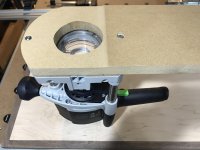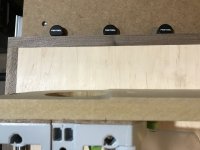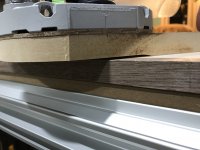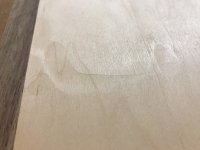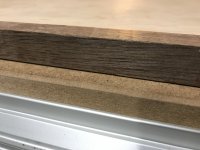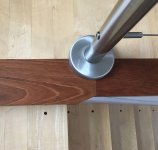Since I already have edge banding on all 4 sides of my first shelf, the tall fence for router table or table saw methods wouldn’t work so I decided to build a jig for my OF1400. While it didn’t turn out terrible, and it’s mostly fine, I’m not completely sold that it’s how I’ll trim edge banding in the future.
I got a slightly damaged 2’ x 4’ sheet of MDF from HD for $5. I ripped a piece as wide as the router and cross cut it to about a foot long. I traced the front of the router to the board and cut it off with a jigsaw for better appearance. I then removed the bottom plate of the router, traced the 2 bolt and center holes, and drilled/cut them out. Finally, I put a piece of painters tape on my jointer and ran the MDF through the jointer until the back lined up with the tape, shut the jointer off, lowered it for a deeper cut, and repeated a few times until I’d removed about 2mm from the front half of the jig.
View attachment 1View attachment 2View attachment 3
For the most part the jig works amazing and finished the edge banding very nicely; however, the edge banding has a few places were it’s not completely smooth and there’s a few small marks in the plywood veneer. I’m not sure if it’s because the plywood is not perfectly straight or because the router has a tendency to tilt forward and I didn’t hold the back down hard enough.
I can hand plane / sand most of the marks, and the systainers will cover most of the shelf anyways, but if I had to do this again, I’d try to mitigate these issues by making the jig a little longer so I didn’t have to work so hard to hold it down (the bit was only 1/2” wide, I couldn’t see well through the dust hood, and corners take some finagling so it took several minutes to complete).
View attachment 4View attachment 5
That said, it would be much quicker and take far less muscle to take one or two passes down the table saw with a tall fence, which I can really appreciate, so I’ll try this method on next few shelves and post my progress so everybody can see the results.
Stay tuned ...

